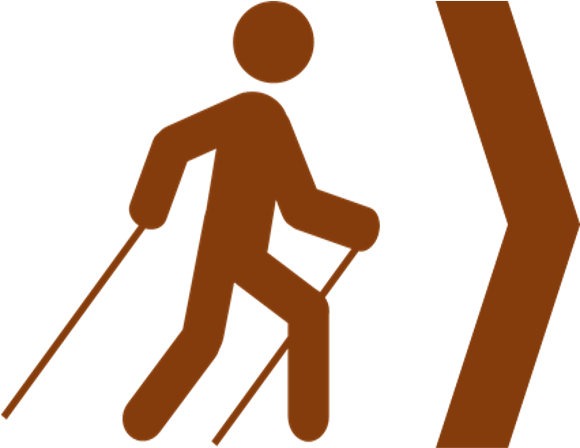Hack your walk with Nordic Walking Guy’s 3 rules:
- Walk with purpose!
- Be consistent!
- Remember everything counts but not everything matters!
Find online: #NordicWalking
Nordic walking, a dynamic exercise that combines walking with the use of specially designed poles, offers a multitude of health benefits for individuals of all ages and fitness levels. Originating in Finland as a training method for cross-country skiers, this low-impact, full-body workout has gained global popularity for its ability to enhance physical and mental well-being. From strengthening bones to fostering social connections, Nordic walking provides a versatile and accessible way to improve overall health. The following sections explore the key benefits, highlighting why this activity is an excellent choice for anyone seeking a sustainable and enjoyable fitness routine.
- Bone health: Nordic walking promotes bone health by providing weight-bearing exercise that stimulates bone growth and strengthens skeletal structure. The repetitive impact of walking with poles encourages bone density, particularly in the lower body and spine. Regular practice can help reduce the risk of osteoporosis, especially in older adults. It’s a low-impact activity, making it suitable for those with joint concerns while still supporting bone strength.
- Improved balance and coordination: Nordic walking enhances balance and coordination by engaging the upper and lower body simultaneously through pole use. The poles provide additional stability, reducing the risk of falls, especially on uneven terrain. Coordinating arm and leg movements improves motor skills and proprioception. This makes it an excellent exercise for older adults or those recovering from injuries.
- Improved cognitive function: Nordic walking boosts cognitive function by increasing blood flow to the brain, which supports memory and mental clarity. The rhythmic nature of the activity can have a meditative effect, reducing stress and improving mood. Engaging in outdoor walking also stimulates the brain through environmental interaction. Studies suggest regular aerobic exercise like Nordic walking may lower the risk of cognitive decline.
- Improved posture and flexibility: Nordic walking encourages proper posture by engaging core muscles and promoting an upright stance while using poles. The arm and shoulder movements increase upper body flexibility, counteracting tightness from sedentary lifestyles. Regular practice strengthens back and abdominal muscles, supporting spinal alignment. This leads to reduced slouching and greater ease of movement in daily activities.
- Improved strength and endurance: Nordic walking builds strength and endurance by engaging multiple muscle groups, including the arms, shoulders, core, and legs. The use of poles increases resistance, making it a full-body workout that enhances muscular endurance. Over time, practitioners develop greater cardiovascular stamina, allowing for longer, more intense sessions. It’s an effective way to improve overall fitness without high-impact strain.
- Increased self-confidence: Nordic walking fosters self-confidence by helping individuals achieve fitness goals and improve physical capabilities. Mastering the technique and noticing progress in strength or endurance boosts a sense of accomplishment. The ability to exercise outdoors in various environments enhances feelings of independence and resilience. Group walking sessions can further reinforce confidence through social support and shared experiences.
- Reduced joint stress: Nordic walking reduces joint stress by distributing body weight across the poles, lessening the impact on knees, hips, and ankles. The poles absorb some of the force exerted during walking, making it gentler than running or traditional walking. This low-impact nature is ideal for those with arthritis or joint pain. It allows for longer exercise sessions without discomfort, promoting joint mobility.
- Social interaction: Nordic walking encourages social interaction through group classes or walking clubs, fostering a sense of community. Walking with others provides opportunities for conversation and bonding, which can improve mental well-being. Group settings also motivate participants to stay consistent with their exercise routine. These social connections can reduce feelings of loneliness and enhance overall quality of life.
- Weight management: Nordic walking supports weight management by burning more calories than regular walking due to the full-body engagement of pole use. It increases heart rate and energy expenditure, aiding in fat loss when paired with a balanced diet. The activity’s accessibility allows for regular, sustainable exercise, key to maintaining a healthy weight. It also builds muscle, which boosts metabolism over time.
Nordic walking stands out as a holistic exercise that delivers a wide range of physical, mental, and social benefits, making it an ideal activity for diverse populations. By improving bone health, balance, cognitive function, and more, it supports both immediate wellness and long-term vitality. Its low-impact nature and adaptability ensure it can be tailored to individual needs, while its social aspects foster community and motivation. Whether you’re aiming to manage weight, boost confidence, or simply enjoy the outdoors, Nordic walking offers a rewarding path to a healthier, more active lifestyle.
↓ See below for Nordic walking coaching, experiences, and shopping ↓
Apparel and accessories: Check these items out, and browse more ideas for outfitting yourself (commission earned by Afoot Nordic Walking on purchases)
Join Nordic Walking Groups on Facebook to share tips, ideas, and experiences. Beginners and those exploring Nordic walking interact with certified instructors and experienced Nordic walkers in a friendly, affirming, and cheerful environment.
Nordic Walking Guy’s first rule is “Walk with purpose!” Walking with purpose includes living a life with meaning. Buy Your Unfinished Business: Find God in Your Circumstances, Serve Others in Theirs to learn more about faith, calling, and resilience.


